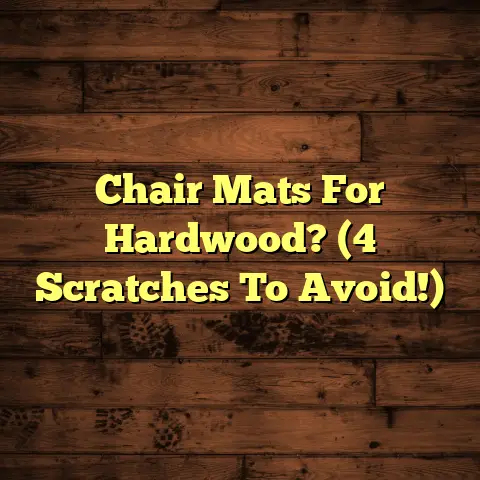Is Wood Flooring Good For Health? (5 Risks!)
Choosing wood flooring can feel a lot like picking a diet. Some choices are healthy and nourishing, while others? Well, they might look good but could have hidden downsides. Just like that tempting but sugary treat, wood flooring, while beautiful, can come with its own set of health risks. Let’s dive into the real deal about wood floors and your health.
1. The Allure of Wood Flooring
Wood flooring is a classic for a reason. I see it all the time. It brings a natural, warm vibe to any home. Plus, it can seriously boost your property value. Who doesn’t love the look and feel of a real wood floor?
But here’s the thing I always tell my clients: Don’t get blinded by the beauty! You’ve got to consider the potential health impacts too. It’s not all sunshine and perfectly polished planks.
2. Risk 1 – Allergens and Dust Accumulation
Think about it: wood floors aren’t perfectly sealed. Tiny cracks and gaps can become havens for dust, pollen, and even pet dander. And trust me, they will accumulate!
If you or anyone in your family suffers from allergies or asthma, this can be a real problem. I’ve seen it firsthand. All that trapped stuff gets kicked up into the air every time someone walks by, triggering those nasty symptoms.
According to the EPA, indoor air can be 2 to 5 times, and occasionally more than 100 times, more polluted than outdoor air. That’s a scary thought, right? And dusty floors definitely contribute to that.
Here’s a quick tip: Regular and thorough cleaning is key! Vacuum often with a HEPA filter vacuum cleaner. And don’t forget to mop – but be careful not to over-wet the wood.
3. Risk 2 – Chemical Emissions from Finishes and Treatments
This is a big one, and something I’m very particular about. Many wood floor finishes and treatments contain volatile organic compounds (VOCs). These chemicals evaporate into the air, and we end up breathing them in.
VOCs can cause a range of health problems, from headaches and eye irritation to more serious long-term effects. Some common chemicals found in these products include:
- Formaldehyde: A known carcinogen.
- Toluene: Can affect the nervous system.
- Xylene: Can cause respiratory issues.
I always recommend my clients to look for low-VOC or zero-VOC finishes. They might cost a bit more upfront, but the health benefits are worth it in the long run.
Did you know? The Green Building Council offers certifications like LEED that prioritize low-emitting materials. Keep an eye out for those!
4. Risk 3 – Slips and Falls
Okay, let’s talk about safety. Wood floors can be slippery, especially if they’re highly polished or if you have kids running around in socks. I’ve seen too many accidents happen.
Falls are a leading cause of injury, especially for older adults. According to the CDC, each year, millions of older people—older than 65—fall. In fact, more than one out of four older people falls each year.
Think about it: a fall on a hard wood floor can lead to fractures, head injuries, and other serious problems.
What can you do? Area rugs with non-slip pads can help. Also, make sure the floors are kept clean and dry. And consider a finish that provides a bit more grip.
5. Risk 4 – Maintenance and Mold Issues
Wood and water? Not a great mix! If wood floors aren’t properly maintained, moisture can seep in, leading to mold growth. And mold? That’s a serious health hazard.
Mold exposure can cause respiratory problems, allergic reactions, and even neurological issues. I’ve had clients who didn’t realize they had a mold problem until their health started to decline.
Here’s the deal: Clean up spills immediately. Maintain proper humidity levels in your home (between 30-50%). And if you live in a humid area, consider a dehumidifier.
Pro Tip: Check for leaks around windows, doors, and plumbing. These are common entry points for moisture.
6. Risk 5 – Sustainability and Environmental Health
This might not seem like a direct health risk, but it’s connected. The wood flooring industry can have a significant environmental impact, including deforestation and habitat destruction.
When forests are destroyed, it affects air quality, water quality, and the overall health of the planet. And guess what? That impacts our health too.
I always encourage my clients to choose sustainably sourced wood. Look for certifications like the Forest Stewardship Council (FSC). These certifications ensure that the wood comes from responsibly managed forests.
Think about the lifecycle of your flooring: Where did it come from? How was it processed? What happens to it when you replace it? Making informed choices can make a big difference.
Conclusion
So, is wood flooring good for health? It’s complicated. While it offers aesthetic appeal and can increase property value, it also comes with potential health risks.
Let’s recap those risks:
- Allergens and dust accumulation: Trapped particles can trigger allergies and respiratory issues.
- Chemical emissions: VOCs from finishes can harm indoor air quality.
- Slips and falls: Hard surfaces can lead to injuries.
- Mold issues: Moisture buildup can cause mold growth and related health problems.
- Sustainability: Unsustainable practices can harm the environment, impacting our health.
Ultimately, the decision is yours. But I hope this article has helped you weigh the risks and benefits of wood flooring. By being informed and taking the right precautions, you can enjoy the beauty of wood floors while protecting your health and the environment.
Remember to always consult with a professional flooring contractor and consider your specific needs and circumstances. Your health is worth it!





